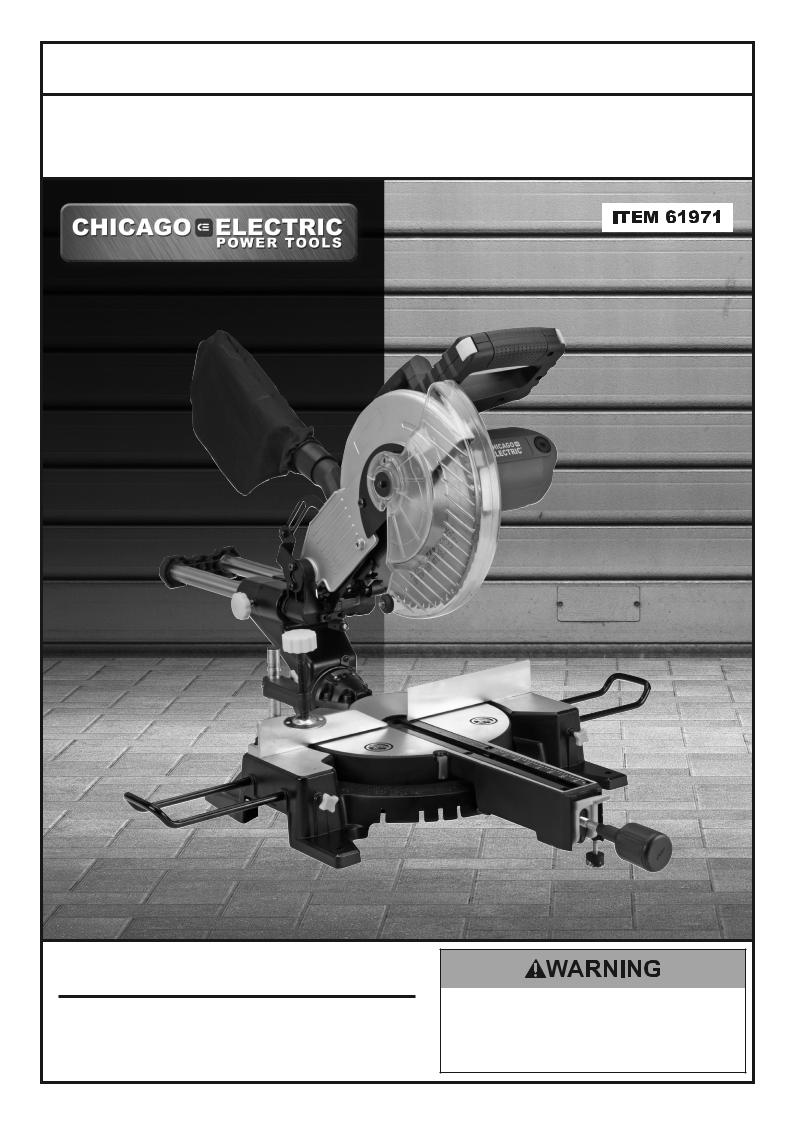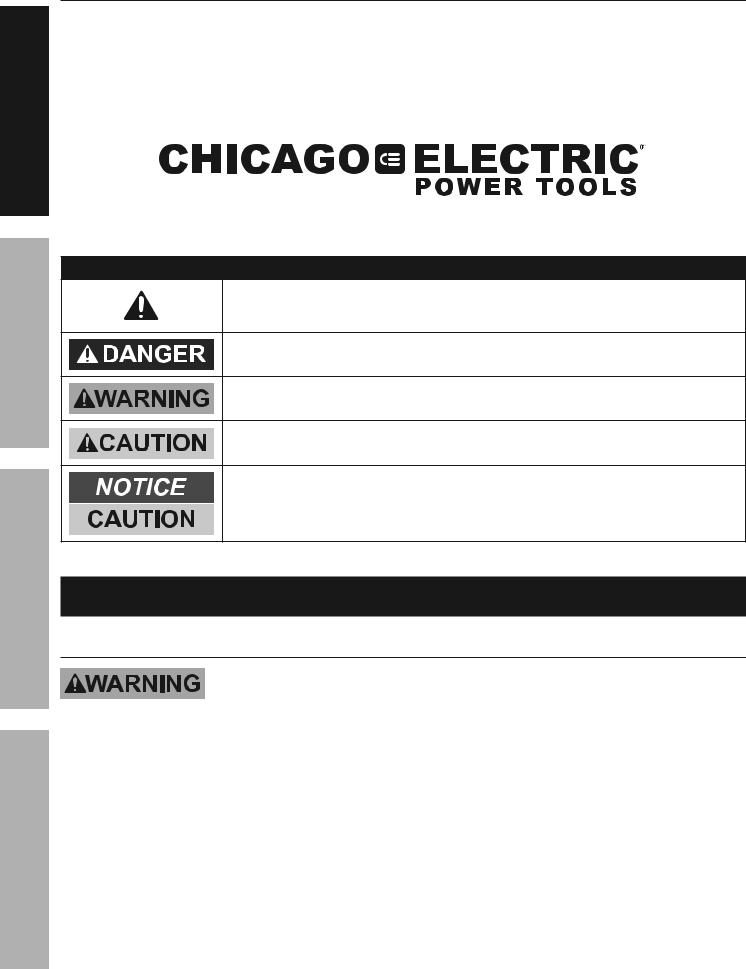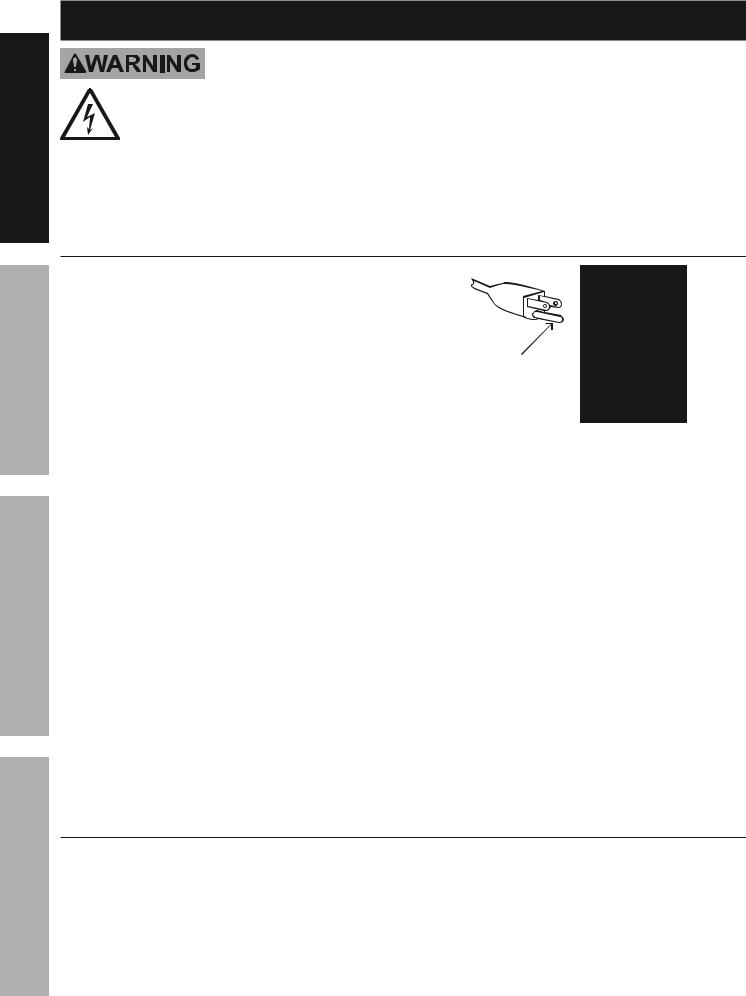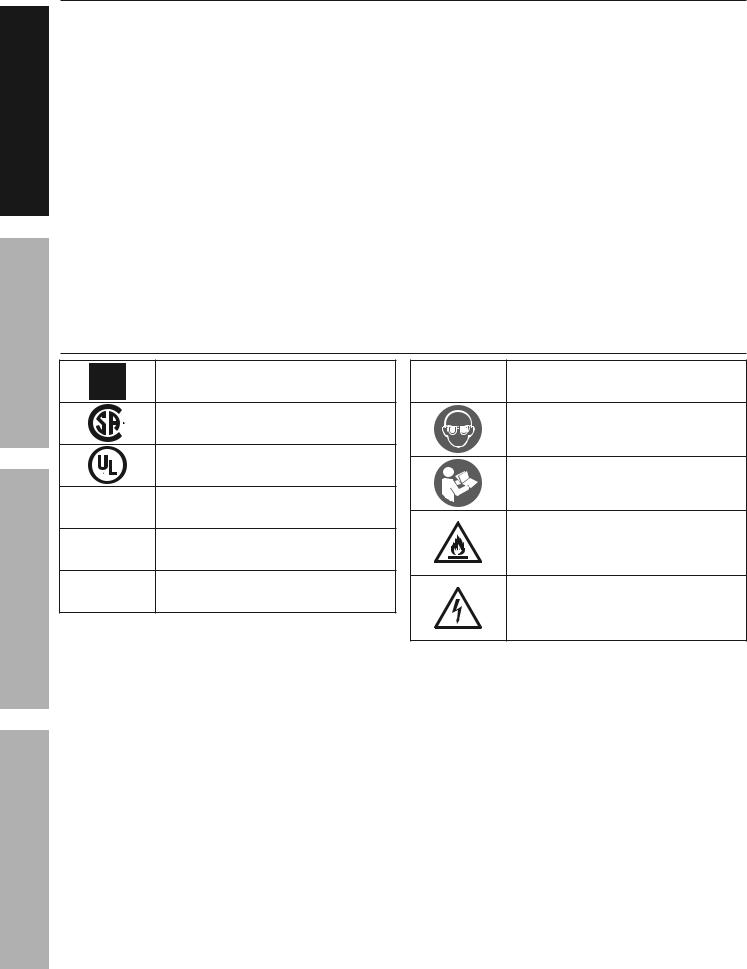Chicago Electric 61971 User Manual

Owner’s Manual & Safety Instructions
Save This Manual Keep this manual for the safety warnings and precautions, assembly, operating, inspection, maintenance and cleaning procedures. Write the product’s serial number in the back of the manual near the assembly diagram (or month and year of purchase if product has no number). Keep this manual and the receipt in a safe and dry place for future reference.
10" SLIDING COMPOUND
MITER SAW
WITH LASER GUIDE SYSTEM
|
Note: Blade sold separately. |
|
Visit our website at: http://www.harborfreight.com |
REV 14i |
Email our technical support at: productsupport@harborfreight.com |
When unpacking, make sure that the product is intact and undamaged. If any parts are missing or broken, please call 1-888-866-5797 as soon as possible.
Copyright© 2013 by Harbor Freight Tools®. All rights reserved.
No portion of this manual or any artwork contained herein may be reproduced in any shape or form without the express written consent of Harbor Freight Tools.
Diagrams within this manual may not be drawn proportionally. Due to continuing improvements, actual product may differ slightly from the product described herein.
Tools required for assembly and service may not be included.
Read this material before using this product. Failure to do so can result in serious injury. SAVE THIS MANUAL.

afetyS
etupS
perationO
Table of Contents
Safetye |
2 |
Maintenancei |
14 |
Specifications.............................................. |
7 |
Parts List and Diagram............................... |
17 |
Setup........................................................... |
8 |
Warranty..................................................... |
20 |
Operation |
10 |
|
|
WARNING SYMBOLS AND DEFINITIONS
This is the safety alert symbol. It is used to alert you to potential personal injury hazards. Obey all safety messages that
follow this symbol to avoid possible injury or death.
Indicates a hazardous situation which, if not avoided, will result in death or serious injury.
Indicates a hazardous situation which, if not avoided, could result in death or serious injury.
Indicates a hazardous situation which, if not avoided, could result in minor or moderate injury.
Addresses practices not related to personal injury.
IMPORTANT SAFETY INFORMATION
General Tool Safety Warnings
aintenanceM
Read all safety warnings and all instructions.
Failure to follow the warnings and instructions may result in electric shock, fire and/or serious injury.
Save all warnings and instructions for future reference.
1.KEEP GUARDS IN PLACE and in working order.
2.REMOVE ADJUSTING KEYS AND WRENCHES. Form habit of checking to see that keys and adjusting wrenches are removed from tool before turning it on.
3.KEEP WORK AREA CLEAN.
Cluttered areas and benches invite accidents.
4.DON’T USE IN DANGEROUS ENVIRONMENT. Don’t use power tools in damp or wet locations,
or expose them to rain. Keep work area well lighted.
5.KEEP CHILDREN AWAY. All visitors should be kept safe distance from work area.
6.MAKE WORKSHOP KID PROOF with padlocks, master switches, or by removing starter keys.
7.DON’T FORCE TOOL. It will do the job better and safer at the rate for which it was designed.
8.USE RIGHT TOOL. Don’t force tool or attachment to do a job for which it was not designed.
Page 2 |
For technical questions, please call 1-888-866-5797. |
Item 61971 |

General Tool Safety Warnings (continued)
Table A: RECOMMENDED MINIMUM WIRE GAUGE
FOR EXTENSION CORDS
(120 VOLT)
NAMEPLATE |
EXTENSION CORD |
|||
AMPERES |
|
LENGTH |
|
|
(at full load) |
25′ |
50′ |
100′ |
150′ |
0 – 6 |
18 |
16 |
16 |
14 |
6.1 – 10 |
18 |
16 |
14 |
12 |
10.1 – 12 |
16 |
16 |
14 |
12 |
12.1 – 16 |
14 |
12 |
Do not use. |
|
9.USE PROPER EXTENSION CORD. Make sure your extension cord is in good condition. When using an extension cord, be sure to use one heavy enough to carry the current your product will draw. An undersized cord will cause a drop in line voltage resulting in loss of power and overheating. Table A shows the correct size to use depending on cord length and nameplate ampere rating.
If in doubt, use the next heavier gauge. The smaller the gauge number, the heavier the cord.
10.WEAR PROPER APPAREL. Do not wear loose clothing, gloves, neckties, rings, bracelets, or other jewelry which may get caught in moving parts. Nonslip footwear is recommended.
Wear protective hair covering to contain long hair.
11.ALWAYS USE SAFETY GLASSES. Also use face or dust mask if cutting operation is dusty. Everyday eyeglasses only have impact resistant lenses, they are NOT safety glasses.
12.SECURE WORK. Use clamps or a vise to hold work when practical. It’s safer than using your hand and it frees both hands to operate tool.
13.DON’T OVERREACH.
Keep proper footing and balance at all times.
14.MAINTAIN TOOLS WITH CARE.
Keep tools sharp and clean for best and safest performance. Follow instructions for lubricating and changing accessories.
15.DISCONNECT TOOLS before servicing when changing accessories, such as blades, bits, cutters, and the like.
16.REDUCE THE RISK OF UNINTENTIONAL STARTING. Make sure switch is in
off position before plugging in.
17.USE RECOMMENDED ACCESSORIES. Consult the owner’s manual for recommended accessories. The use of improper accessories may cause risk of injury to persons.
18.NEVER STAND ON TOOL. Serious injury could occur if the tool is tipped or if the cutting tool is unintentionally contacted.
19.CHECK DAMAGED PARTS. Before further use of the tool, a guard or other part that is damaged should be carefully checked to determine that
it will operate properly and perform its intended function – check for alignment of moving parts, binding of moving parts, breakage of parts, mounting, and any other conditions that may affect its operation. A guard or other part that is damaged should be properly repaired or replaced.
20.DIRECTION OF FEED. Feed work into a blade or cutter against the direction of rotation of the blade or cutter only.
21.NEVER LEAVE TOOL RUNNING UNATTENDED. TURN POWER OFF. Don’t leave tool until it comes to a complete stop.
Safety
Setup
Operation
Maintenance
Item 61971 |
For technical questions, please call 1-888-866-5797. |
Page 3 |

afetyS
etupS
perationO
aintenanceM
Grounding Instructions
TO PREVENT ELECTRIC SHOCK AND DEATH FROM INCORRECT GROUNDING WIRE CONNECTION:
Check with a qualified electrician if you are in doubt as to whether the outlet is properly grounded. Do not modify the power cord plug provided with the tool. Never remove the
grounding prong from the plug. Do not use the tool if the power cord or plug is damaged. If damaged, have it repaired by a service facility before use. If the plug will not fit the outlet, have a proper outlet installed by a qualified electrician.
110-120 VAC Grounded Tools: Tools with Three Prong Plugs
1.In the event of a malfunction or breakdown, grounding provides a path of least resistance for electric current to reduce the risk of electric shock. This tool is equipped with an electric cord having an equipment-grounding conductor and a grounding plug. The plug must be plugged into a matching outlet that is properly installed and grounded in accordance with all local codes and ordinances.
2.Do not modify the plug provided – if it will not fit the outlet, have the proper outlet installed by a qualified electrician.
3.Improper connection of the equipment-grounding conductor can result in a risk of electric shock. The conductor with insulation having an outer surface that is green with or without yellow stripes is the equipment-grounding conductor.
If repair or replacement of the electric cord or plug is necessary, do not connect the equipmentgrounding conductor to a live terminal.
4.Check with a qualified electrician or service personnel if the grounding instructions are not completely understood, or if in doubt as to whether the tool is properly grounded.
5.Use only 3-wire extension cords that have 3-prong grounding plugs and 3-pole receptacles that accept the tool’s plug.
6.Repair or replace damaged or worn cord immediately.
Figure A: 125 VAC 3-Prong Plug and Outlet (for up to 125 VAC and up to 15 A)
7.This tool is intended for use on a circuit that has an outlet that looks like the one illustrated above in Grounding. The tool has a grounding plug
that looks like the plug illustrated above in Grounding.
8.The outlet must be properly installed and grounded in accordance with all codes and ordinances.
9.Do not use an adapter to connect this tool to a different outlet.
10.The tool must be plugged into an appropriate outlet, properly installed and grounded in accordance
with all codes and ordinances. The plug and outlet should look like those in the preceding illustration.
(See 3-Prong Plug and Outlet.)
Miter Saw Safety Warnings
|
For Your Own Safety Read Instruction Manual Before Operating Miter Saw |
|||
1. |
Wear eye protection. |
5. |
Never reach around saw blade. |
|
2. |
Keep hands out of path of saw blade. |
6. |
Turn off tool and wait for saw blade to stop |
|
3. |
Do not operate saw without guards in place. |
|
before moving workpiece or changing settings. |
|
7. |
Disconnect power before changing |
|||
4. |
Do not perform any operation freehand. |
|||
|
blade or servicing. |
|||
Page 4 |
For technical questions, please call 1-888-866-5797. |
Item 61971 |

Miter Saw Safety Warnings (continued)
8.Return all guards to original position if any are moved during blade replacement. Check all guards for proper operation after service.
9.Always use blades with correct size and shape (diamond versus round) of arbor holes. Blades that do not match the mounting hardware of the saw will run eccentrically, causing loss of control.
10.Never use damaged or incorrect blade washers or bolt. The blade washers and bolt were specially designed for your saw, for optimum performance and safety of operation.
11.Do not use to cut logs, tree limbs, or uneven lumber.
12.Wet lumber, green (unseasoned) lumber, and pressure treated lumber all have an increased potential for kickback and should only be cut with a blade for cutting that lumber type. Wear a NIOSHapproved respirator and have appropriate ventilation whenever cutting pressure treated lumber.
13.Do not use blades made from high speed steel, abrasive blades, metal-cutting blades
or masonry-cutting blades. The guards of this saw are not designed to protect against the failure of such blades.
14.Blades must be rated to at least the maximum speed marked on the tool.
15.DO NOT OPERATE WITH ANY GUARD DISABLED, DAMAGED, OR REMOVED. Moving guards must move freely and close instantly.
16.The use of accessories or attachments not recommended by the manufacturer may result in a risk of injury to persons.
17.When servicing use only identical replacement parts.
18.Do not depress the Spindle Lock when starting or during operation.
19.Only use safety equipment that has been approved by an appropriate standards agency. Unapproved safety equipment may not provide adequate protection. Eye protection must be ANSI-approved and breathing protection must be NIOSH-approved for the specific hazards in the work area.
20.Stay alert, watch what you are doing and use common sense when operating a power tool. Do not use a power tool while you are tired or
under the influence of drugs, alcohol or medication. A moment of inattention while operating power tools may result in serious personal injury.
21.Industrial applications must follow OSHA guidelines.
22.Maintain labels and nameplates on the tool. These carry important safety information.
If unreadable or missing, contact Harbor Freight Tools for a replacement.
23.Avoid unintentional starting.
Prepare to begin work before turning on the tool.
24.People with pacemakers should consult their physician(s) before use. Electromagnetic fields in close proximity to heart pacemaker could cause pacemaker interference or pacemaker failure.
25.WARNING: Some dust created by power sanding, sawing, grinding, drilling, and other construction activities, contains chemicals known to the State of California to cause cancer and birth defects or other reproductive harm. Some examples of these chemicals are:
•Lead from lead-based paints
•Crystalline silica from bricks and cement or other masonry products
•Arsenic and chromium from chemically
treated lumber
Your risk from these exposures varies, depending on how often you do this type of work. To reduce your exposure to these chemicals: work in a well ventilated area, and work with approved safety equipment, such as those dust masks that are specially designed to filter out microscopic particles. (California Health & Safety Code § 25249.5, et seq.)
26.WARNING: The cord of this product contains lead and/or di (2-ethylhexyl) phthalate (DEHP), chemicals known to the State of California
to cause cancer, and birth defects or other reproductive harm. Wash hands after handling. (California Health & Safety Code § 25249.5, et seq.)
27.The warnings, precautions, and instructions discussed in this instruction manual cannot cover all possible conditions and situations that may occur. It must be understood by the operator that common sense and caution are factors which cannot be built into this product, but must be supplied by the operator.
Safety
Setup
Operation
Maintenance
Item 61971 |
For technical questions, please call 1-888-866-5797. |
Page 5 |

afetyS
etupS
perationO
Vibration Safety
This tool vibrates during use. Repeated or long-term exposure to vibration may cause temporary or permanent physical injury, particularly to the hands, arms and shoulders. To reduce the risk of vibration-related injury:
1.Anyone using vibrating tools regularly or for an extended period should first be examined by a doctor and then have regular medical check ups to ensure medical problems are not being caused or worsened from use. Pregnant women or people who have impaired blood circulation to the hand, past hand injuries, nervous system disorders, diabetes, or Raynaud’s Disease should not use this tool. If you feel any medical or physical symptoms related to vibration (such as tingling, numbness, and white or blue fingers), seek medical advice as soon as possible.
2.Do not smoke during use. Nicotine reduces the blood supply to the hands and fingers, increasing the risk of vibration-related injury.
3.Use tools with the lowest vibration when there is a choice between different processes.
4.Include vibration-free periods each day of work.
5.Grip tool as lightly as possible (while still keeping safe control of it). Let the tool do the work.
6.To reduce vibration, maintain the tool as explained in this manual. If any abnormal vibration occurs, stop use immediately.
Symbology
Double Insulated
Canadian Standards Association
Underwriters Laboratories, Inc.
V Volts
~Alternating Current
A Amperes
n0 xxxx/min. No Load Revolutions per Minute (RPM)
WARNING marking concerning Risk of Eye Injury. Wear ANSI approved safety goggles with side shields.
Read the manual before set-up and/or use.
WARNING marking concerning Risk of Fire.
Do not cover ventilation ducts. Keep flammable objects away.
WARNING marking concerning Risk of Electric Shock. Properly connect power cord to appropriate outlet.
 SAVE THESE INSTRUCTIONS.
SAVE THESE INSTRUCTIONS.
aintenanceM
Page 6 |
For technical questions, please call 1-888-866-5797. |
Item 61971 |
